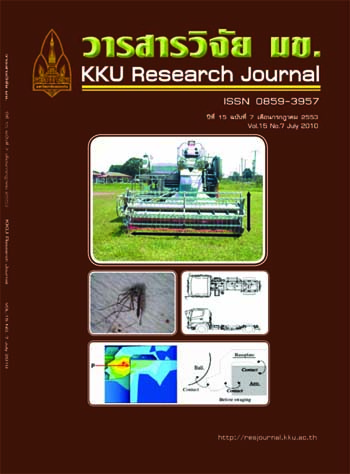The efficiency of ELISA technique in Nosema bombycis N. of mulberry silkworm (Bombyx mori L.) detection (Thai)
Main Article Content
Abstract
Pebrine disease caused by Nosema bombycis N. is the most devastating disease of mulberry silkworm (Bombyx mori L.), which transmits continuously through eggs by generation to generation. The infected silkworm “Mae Ling” variety was randomly selected and studied on pebrine symptom development for one generation in laboratory at 25ºC (21.5 – 26ºC, R.H. 38 – 91%). Numbers of pebrine symptoms containing spores were 15 from total 20 symptoms. The infected samples were observed using phase contrast microscope and found the average spores of 1.77 x 106 – > 2.42 x 108 spores/larva with the average spore size of 2.10 – 2.50 × 4.13 – 4.57 µm. The most appearance infected symptom was the resembled healthy larva; which had 10 percent of infection. The spore suspension of N. bombycis was purified using sucrose density gradient centrifugation (SDGC). Most spores located at sucrose level concentration of 40 – 50 % (w/w). Suitable concentration of antigen for polyclonal antibody production was evaluated and found that the spore concentration of 1 × 109 spores/ml was the most properly. The titer value of this antiserum at 101 – 106 spores/ml of antigen was 1:50 and at 106 spores/ml of antigen the titer value was 1:3,500. In addition, the produced antiserum in this present study was highly specific to protozoa N. bombycis (Mae Ling isolate) but not cross reaction to other silkworm pathogens, fungi: Aspergillus flavus, A. tamarii, Metarhizium anisopliae, bacteria: Bacillus thuringiensis, Serratia marcescens, Staphylococcus aureus, S. sciuri and virus: Nucleopolyhedrovirus (NPV). T his antiserum was tested and developed for N. bombycis detection using indirect ELISA to compare with the previous method (IP 1). The developed detection technique was considered consequently based on the important steps in series. The best result obtained from the beginning steps was used to develop continuously in next steps in series, in order to derive the best final procedure. The result of type and concentration including temperature and time interval for incubation of blocking solution exhibited that the 1% BSA (bovine serum albumin) and 2 hr of blocking time at 37°C were the most effectiveness.


